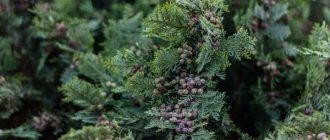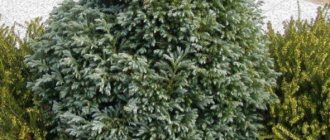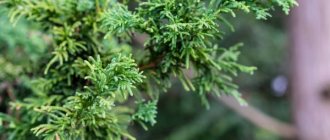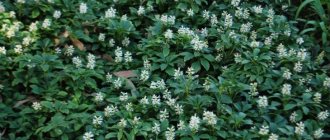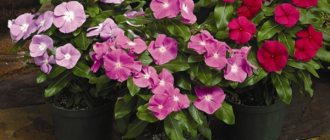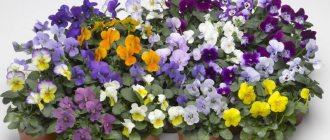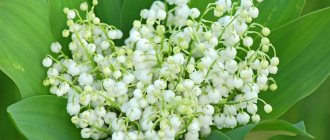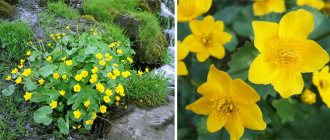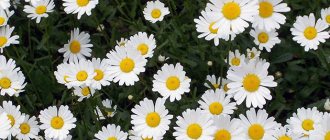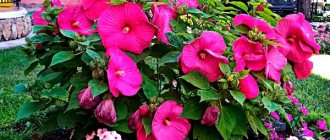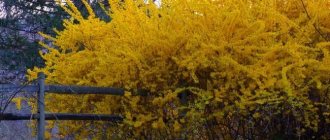Description of Thuja Columna
Thuja western Columna is a coniferous evergreen plant of the cypress family. Thuja occidentalis Columna is highly decorative: it is distinguished by a beautiful columnar crown of a fairly dense and dense shape. The needles of the tree are green, shiny, and have a scale-like structure. The needles are soft, slightly tousled, and have a pleasant spicy aroma. In the cold season, the needles darken somewhat (especially in areas with a more severe climate).
In spring, the leaves of Thuja Columna acquire their original color.
The bark of the tree is reddish-brown. The fruits of the plant look like small cones of light brown color. Thuja roots have a characteristic feature: closely intertwined with mushroom mycelium, they form mycorrhiza, which should be preserved. Dimensions of western thuja Columna: an adult tree has a height of up to 8-9 m, although some specimens grow up to 10 m.
The growth rate of the tree is 15-30 cm.
The diameter of the crown increases annually by 5-7 cm and reaches one and a half meters in an adult plant. This variety of thuja is very frost-resistant. Mature trees can withstand frosts of more than -30 degrees without shelter. In spring, it is recommended to shade the plant slightly to prevent sunburn.
How much do seedlings cost?
It is better to purchase seedlings from nurseries
The cost of seedlings varies depending on the size of the plant.
| Seedling height | Cost (in official nurseries), rub. |
| 30 cm | 250-350 |
| from 1.6 to 1.8 m | 3000- 3500 |
| From 1.8 to 2 m | 4200 |
| From 2.0 to 2.5 m | up to 6000 |
| More than 2.5 | From 6000 |
In spontaneous markets, prices are much lower, but the risk of purchasing a diseased plant there is much higher.
The use of thuja Columna in landscape design
Thuja Columna has high aesthetic value. The varietal qualities of the tree: crown shape, frost resistance, annual growth allow it to fit perfectly into landscape projects of various areas. The plant is most often used:
- for planting hedges;
- when designing alleys;
- as free-standing trees in complex landscaping;
- on an alpine hill as a central conifer.
Thuja Columna easily tolerates the effects of harmful emissions into the atmosphere, so it can be planted even along highways.
Thuja Columna hedge
Thuja Western Columna looks ideal when creating a hedge. Having a dense cone-shaped shape and dense branches, the seedlings easily form a continuous column of plants. The slow growth of the tree allows it to go for a long time without a drastic pruning. Considering the size of the thuja occidentalis, the distance in the row when planting should be at least 50-70 cm. As a material for hedges, the thuja occidentalis Columna is undoubtedly the most practical and decorative variety.
Photo of a Thuja Columna hedge
Thuja varieties for the Moscow region
Frost-resistant varieties that grow well in the climatic conditions of the middle zone are suitable for the Moscow region.
Hosery
Thuja for the Moscow region, which is better? In addition to the varieties described above Brabant, Golden Brabant, Columna, the following thujas are also suitable for the middle zone:
- Emerald. A tall tree (up to 5 m), reminiscent of cypress. The crown is pyramid-shaped, dense and narrow. The needles have an emerald green hue that does not change with the changing seasons. Thuja grows slowly, about 10 cm in height, 5 cm in width. One of the best varieties for the middle zone, as it is resistant to changing climatic conditions.
- Hosery. Shrub in the shape of a ball. The scaly needles have a dark green tint in the warm season, and bronze in the cold season. The height and width of an adult thuja plant are 60-80 cm. It grows equally well in the light and in the shade, without changing the color of the needles.
- Golden Globe. This dwarf thuja has a loose, spherical crown, the density of which is achieved through regular trimming. Plant growth is 1 m high and 1.2 m wide. The annual growth is about 10 cm. The needles on the inside of the crown are green, the tips of the shoots give off a light green-yellow tint in the sun. In the shade the shade turns green. In the cold season, the plant takes on copper tones.
- Danica. A small bush in the shape of a ball. The crown is dense, with vertically arranged branches. The plant has soft and thin scaly needles. The growth of thuja is slow (5 cm in height and 4 cm in width per year).
- Reingold. The crown is initially spherical, but gradually becomes cone-shaped. This variety grows slowly - up to 10 cm in height and 5 cm in width per year. The needle-shaped needles gradually become covered with scales. In summer sunlight the needles turn golden, in winter they turn bronze. You should not place Reingold in the shade, as the color and density of the crown deteriorate.
- Globoza. The shrubs are distinguished by their spherical crown shape, diameter and height up to 2 m. In spring, the needles are light green in color, in summer – green, in winter – brownish. Growth is slow, only 5 cm in height and width per year. The variety is frost-resistant, but it is recommended to tie the branches for the winter to avoid them breaking off under the weight of snow.
Features of reproduction
Thuja Columna cuttings are carried out much more often than propagation by seeds. The advantage of this method is the preservation of the maternal varietal qualities of the plant. With the help of cuttings, it is possible to obtain several dozen plants in 2-3 years. Cuttings are usually carried out in the spring:
- For cuttings, apical shoots are taken from young trees.
- The branch is sharply broken off so that a piece of bark remains on the shoot - the “heel”.
- Rooting of cuttings is possible in water, substrate, sphagnum moss, or using a wick.
Rooted cuttings are planted in small pots with special soil for conifers.
Propagation by seeds requires long-term stratification. To do this, having received the seeds from the cones in the fall, they are buried in the ground for the winter. In the spring, the seeds can be sown. The disadvantages of this method are that the seedling retains only its species and a long period (up to 5 years) of cultivation. In practice, gardeners most often buy ready-made seedlings in the store, because... young conifers grow rather slowly. When purchasing, you need to pay attention to the correctness of the crown; the plant must have a healthy root system.
It is advisable to purchase seedlings with a lump of earth.
Reviews from gardeners
Arborvitae are now perhaps the most popular plants in Russian dachas. Gardeners like their long decorative season and their tolerance for haircuts to suit any figure.
Owners of country houses note a significant improvement in the composition of the air in their areas and a decrease in colonies of blood-sucking insects after planting.
Young mothers with babies feel at ease in gardens with hedges from Columna: its soft needles do not scratch the child, and at the same time serve as a reliable boundary for the play area.
Flower growers involved in landscape design are happy to use thuja in their compositions: thanks to its slow growth, the design is not disrupted for a long time.
Weekend summer residents say that culture requires a minimum of effort. This is especially true for shaping haircuts.
The only thing that owners don’t like is the requirement to tie up the crown and cover the plants for the winter. For large plantings this is a significant labor investment. However, upon reaching the age of 4-5 years, the need for these operations disappears.
Conifers are popular among landscape designers because they remain green all year round. Thuja is one of the varieties of plants with which it is easy to create a hedge on a site.
Thuja Western Columna - planting and care
Recommended timing
Planting can be done in spring or autumn. It is advisable to plant in late spring in warm soil so that the plant has time to adapt. When planting in the fall, the plant does not have time to take root, so the stem needs to be strengthened with guy wires.
Site selection and soil preparation
Thuja Columna grows well in lightly shaded areas, although it can also tolerate fully lit areas. For planting, it is advisable to choose places protected from the wind. A planting hole is first prepared, which is significantly larger in size than the soil ball of the seedling. Drainage consisting of gravel, expanded clay or broken brick is poured into the bottom of the pit. The hole is filled with planting mixture:
- turf land – 50%
- peat – 25%
- sand – 25%
The substrate is thoroughly mixed with 500 g of complex mineral fertilizer.
Algorithm for planting thuja Columna
It is advisable to plant thuja together in order to keep the seedling in an upright position.
- Before planting, you need to try on the seedling; the root collar should be located at the same level with the ground or slightly higher.
- Having placed the plant in the center of the hole strictly vertically, fill the soil around the perimeter.
- The soil around the seedling should be thoroughly compacted using fists or trampling. As a result, there should be a small hole around the tree.
- The plant is watered abundantly, using 30-40 liters of water per tree.
- After watering, you need to inspect the trunk and, if necessary, add more soil or, conversely, remove some soil.
Description of caring for Thuja Columna after planting
The surface of the tree trunk circle should be mulched. It is necessary to water the plant weekly. If the tree stem is weak, you need to tie it to a peg so that strong winds do not break the seedling.
How to plant?
If you plant thuja correctly, then in the future it will delight you with its attractive appearance. An open sunny area or a space with some shade is best. Planting in the shade, where there is practically no sun and is very dry, will cause the plant to wither over time, turn yellow and die. When choosing a suitable place for Columna, you should choose something that is protected from the wind.
Read also: Soaked viburnum for the winter recipes
In practice, it turns out that strong gusts can cause the tree to break, especially if it is quite tall.
The type of soil in which the thuja will grow does not play a big role. If possible, only then do experienced gardeners advise using fertile soil with a slightly acidic or alkaline composition. But breathability will require more attention. When planting in clay or sub-clay soil, high-quality drainage is required, which is formed at a distance of 20 centimeters into the soil. Groundwater should not linger, otherwise it will cause rotting of the root system.
Experienced gardeners advise adhering to several rules when planting thuja on the site.
- The site requires preliminary preparation. It is first dug up, then a planting hole is prepared, the dimensions of which depend on the volume of the tree’s crown. The width of the pit should be twice this parameter.
- It is worth preparing the soil inside the recess. It is mixed from several components. Take two parts of turf soil, one part of sand and peat. Be sure to add 500 grams of mineral components so that the thuja takes root better.
- The depth of the hole, taking into account the additional soil poured to the bottom, should allow the root system to be immersed up to the root collar. Everything is compacted well and watered.
Important! If a plant is planted in one place for many years, it is worth considering its future dimensions in height and width. There should be no obstacles within a distance of 1.5 meters. Other crops are advised to be planted no closer than 3 meters.
Rules for growing and care
Watering schedule
After planting, the plant should be watered generously once a week for two months. When the plant takes root, watering is carried out as follows: in spring and autumn, twice a month. In summer you should water more often - once a week, and in hot weather twice a week.
Top dressing
In order for thuja to develop normally and have immunity from diseases, organic fertilizers are needed:
- compost;
- humuses;
- humus.
Mineral supplements are required:
- potassium;
- phosphorus;
- nitrogen.
Microelements that thuja urgently needs: calcium, iron, magnesium and manganese. The main shock fertilizing with organic-mineral fertilizer is carried out in the spring, when nutrients are embedded in the ground. In summer, you should also carry out several fertilizing by watering or foliar (on the foliage of trees). Thuja Columna responds well to humus-potassium supplements. We must not forget that fertilizers containing nitrogen should be applied only until August, so that the plant stops growing and is better prepared for winter.
Attention! Fresh manure and chicken droppings should never be applied under the thuja. This can cause plant diseases.
Pruning Thuja Columna
Due to the fact that the tree has an exceptionally regular shape, and the growth rate does not exceed 15-30 cm per year, thuja occidentalis Columna does not need drastic pruning for a long time. In the spring you need to inspect the plant, cut off dried, broken or yellowed branches. You should also trim branches that grow away from the main crown of the tree. Thujas of this variety are long-lived - they grow for about 200 years, so middle-aged thujas should be trimmed so that they do not grow too much.
Preparing for winter
Thuja Columna has high frost resistance and adult plants winter well without shelter. Young seedlings in the first two years of life need shelter; the plant is wrapped in waterproof material and tied with twine. Young plants especially need shelter in the first year after planting. In order for the thuja to overwinter better, it is good to apply potassium-phosphorus fertilizers to the tree trunk circle in the fall, and also water the plant abundantly.
Pests and diseases of thuja Columna
Pests of thuja
- Thuja aphid - usually begins to attack plants from the lower part of the shoots. The needles turn yellow and fall off. The means of combating thuja aphids is Karbofos (Fufanon).
- Thuja false scale - the first traces of damage appear on the tree bark in the form of yellow ulcers. These pests can lead to the death of the plant, so in the spring preventative treatment with one of the drugs against this pest is recommended. False scale insects are well destroyed by such means as: Rogor, Karbofos, Actellik.
- Spider mite - the needles become covered with cobwebs, then turn yellow. Spraying with infusion of garlic or dandelion or colloidal sulfur helps.
- Spotted moth - dangerous larvae that gnaw through the bark. Diseased branches of the plant need to be pruned. You can spray it with Fumitox-anti-mite.
Pests of thuja
Thuja diseases
- Late blight. The disease first affects the root and then spreads to the entire plant. The shoots wilt, the needles acquire a grayish tint. A preventive measure against late blight and other fungal diseases is regular, every 10-14 days, spraying the plant with phytosporin. When signs of disease appear, various fungicides are used: Fundazol, Hom, Ordan.
- Fusarium. Characterized by yellowing and then death of shoots. As a treatment, foundation is used, which is sprayed on the plant and watered at the root.
- Rust and shutte. Signs of this disease are darkening and then falling of the needles. Young thujas are more susceptible to this disease. Sick plants are sprayed with fungicides containing copper: copper sulfate, Oksikhom.
